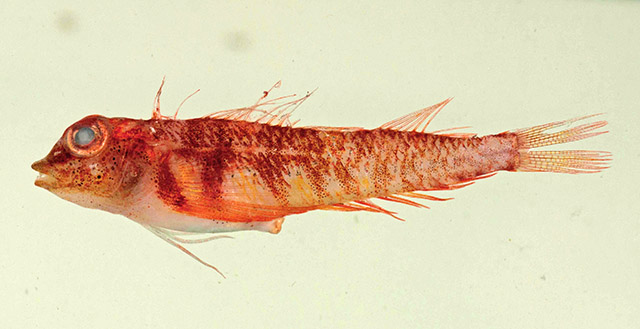| Tripterygiidae (Triplefin blennies), subfamily: Tripterygiinae |
| 3.3 cm SL (male/unsexed) |
|
reef-associated; marine; depth range 2 - 4 m |
| Western Central Pacific: known only from the Baie de St. Vincent, New Caledonia. |
|
Dorsal spines (total): 16-16; Dorsal soft rays (total): 8-9; Anal spines: 1-1; Anal soft rays: 20-20. Short supraorbital tentacle; first dorsal-fin 25% shorter than second dorsal fin; male coloration whitish with fine specks of black dots, darkening on area of opercle; rough reticular pattern of deep reddish brown on body; base of pectoral fin bearing a broad, dark reddish brown bar; anal fin and first 2 dorsal fins dusky colored with weak red rays; transparent caudal fin bearing a reddish white bar at its base, proximal end with vertically aligned reddish dots. Dorsal rays III + XIII + 8-9; lateral line interrupted, 17-18 + 20-21; mandibular pores 5 + 2 + 5 (Ref. 54980). |
| Eggs are hemispherical and covered with numerous sticky threads that anchor them in the algae on the nesting sites (Ref. 240). Larvae are planktonic which occur primarily in shallow, nearshore waters (Ref. 94114). |
|
Least Concern (LC); Date assessed: 03 May 2010 Ref. (130435)
|
| harmless |
Source and more info: www.fishbase.org. For personal, classroom, and other internal use only. Not for publication.

